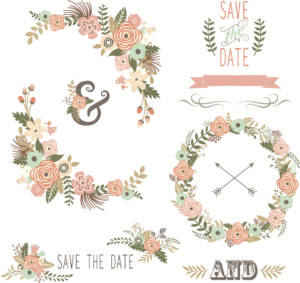
Getting your wedding invitations in the mail with plenty of time for family and friends to respond is key to having a good turnout at your wedding.
If you’re one of the many couples planning a summer wedding, you’re probably thinking about getting your wedding invitations and save-the-date cards out after the first of the year. The invitations set the stage for your wedding. It’s the first opportunity you have to share the style of your celebration. You’ll want to have an idea of what type of ceremony you’re having, classic or modern, elegant or casual. When you order your invitations, you’ll want to consider other wedding stationery, such as menu cards, ceremony programs and thank-you notes, that carry your motif and colors throughout the event.
Making Your Wedding Invitations
Here are some tips and ideas you’ll want to keep in mind when you make your invitations:
- Choose your wording carefully. Learn the rules of how your invitation should be worded. Traditionally, it’s the host of the celebration who is listed first. If you are dealing with multiple sets of parents, you may choose something different to honor everyone. Don’t put too much information on the card. Print separate enclosure cards for directions to the venue and travel information.
- Don’t include registry information in your invitations. Put it on your wedding website and tell your family for when guests ask.
- Order invites and other stationery together and early. This saves you time, money and stress.
- Double or even triple check everything that is printed. Have two or three different people look at the proofs to ensure nothing is missed, misspelled or incorrect.
- Get creative with fonts and coloring, but make sure the invitation is readable.
- When ordering invitations, count mailing addresses, not guests. But remember to add a few extra invites to avoid having to run a reprint later on.
- Send an invite if you’ve sent a save-the-date card. Even if you know the guests cannot attend, send the invitation, because not doing so implies that the guest is no longer invited.
Deadlines
- It’s recommended that you send invitations about six to eight weeks prior to the wedding, but 10 weeks is becoming the norm in these busy times. You have to remember not to send invites too early, because people forget to RSVP. Sending invites too late doesn’t give you enough time to get responses to tell your caterer an official head count.
- When putting an RSVP deadline on the card, give yourself a few extra days between the real date and the date you tell people. For example, you have to give your caterer a head count on June 1. Make the RSVP deadline on May 24, a full week earlier. If you have to spend time calling people, you won’t be so stressed. Giving people a short time to respond makes them take care of it quicker. You might even choose to move the date up even more.
- Help your guests respond to invites with all the information that you require. You might be surprised how many people forget to write their names on the reply cards or just forget to respond at all. Discreetly number the reply cards to correspond to the list of guest names, or consider pre-printing a label for the reply card.
Making Your Wedding Invitations: Outside the Envelope
- Don’t use address labels on the envelope. Hand write them yourself or ask your bridal party to help. If you’re concerned about making mistakes, just get a few extra envelopes. The hand-written address makes the invite feel more personal.
- Get a glue stick to seal the envelopes without damaging the invites.
- Be careful about the outside of the envelope. Use a dark-color ink to address the envelopes to make sure it can be read.
- Check the correct the postage before you mail. Take one envelope with the reply cards inside to the post office and have it weighed and examined. To be sure that the clerk got it correct, mail an invite to yourself before you send out the others.



